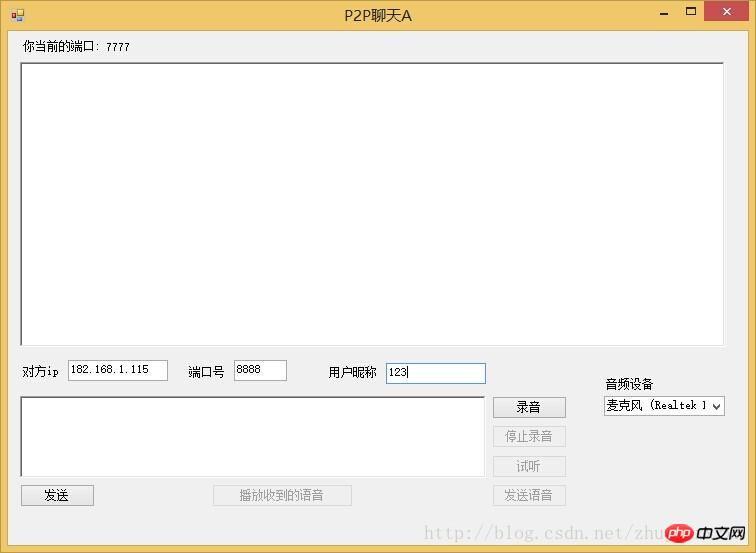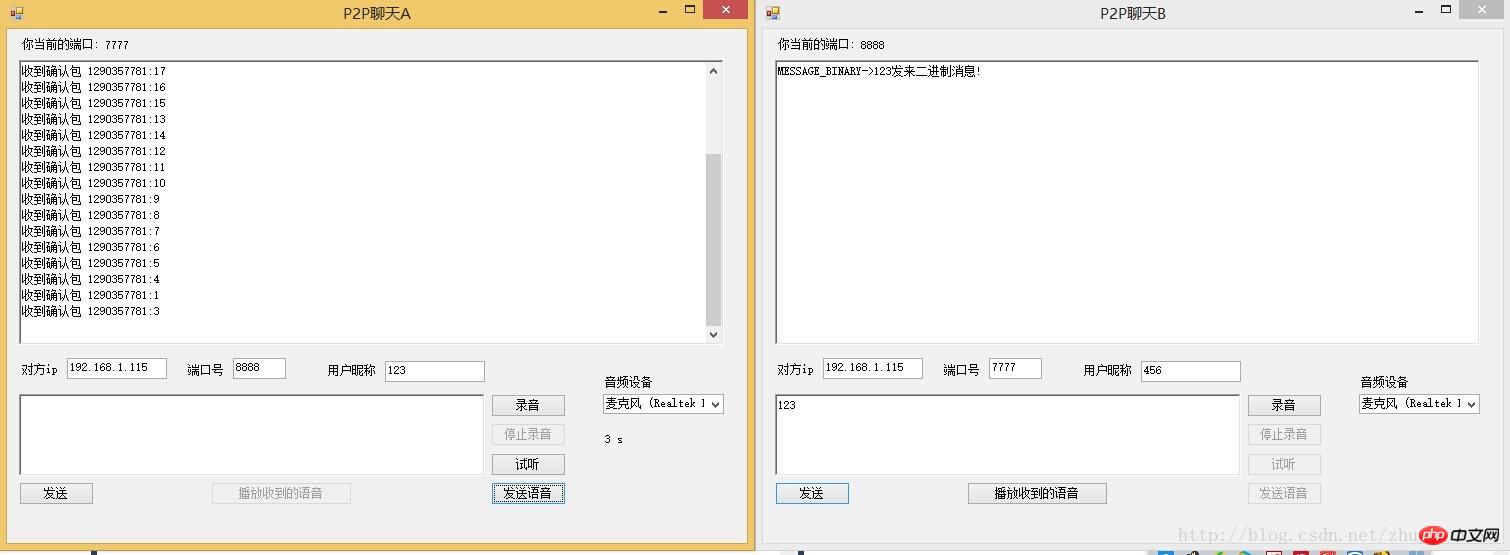C# p2p voice chat tool based on udp
Originality statement
The source of this blog post is http://www.php.cn/If done Please indicate the source. This article is originally written by the author, email zhujunxxxxx@163.com, if you have any questions, please contact the author
##Overview
I posted an article beforehttp://www.php.cn/ The function of sending data in packets of UDP has been implemented, and this article is mainly an application that uses UDP to transmit information such as voice and text. In this system, there is no server and client, and mutual communication is directly related to each other. Can achieve good results.
##Voice acquisition
If you want to send a voice message, you must first obtain the voice. There are several methods. One is to use DirectX's DirectXsound to record. I use it for simplicity. An open source plug-in NAudio to implement voice recording.
Reference NAudio.dll//------------------录音相关-----------------------------
private IWaveIn waveIn;
private WaveFileWriter writer;
private void LoadWasapiDevicesCombo()
{
var deviceEnum = new MMDeviceEnumerator();
var devices = deviceEnum.EnumerateAudioEndPoints(DataFlow.Capture, DeviceState.Active).ToList();
comboBox1.DataSource = devices;
comboBox1.DisplayMember = "FriendlyName";
}
private void CreateWaveInDevice()
{
waveIn = new WaveIn();
waveIn.WaveFormat = new WaveFormat(8000, 1);
waveIn.DataAvailable += OnDataAvailable;
waveIn.RecordingStopped += OnRecordingStopped;
}
void OnDataAvailable(object sender, WaveInEventArgs e)
{
if (this.InvokeRequired)
{
this.BeginInvoke(new EventHandler<WaveInEventArgs>(OnDataAvailable), sender, e);
}
else
{
writer.Write(e.Buffer, 0, e.BytesRecorded);
int secondsRecorded = (int)(writer.Length / writer.WaveFormat.AverageBytesPerSecond);
if (secondsRecorded >= 10)//最大10s
{
StopRecord();
}
else
{
l_sound.Text = secondsRecorded + " s";
}
}
}
void OnRecordingStopped(object sender, StoppedEventArgs e)
{
if (InvokeRequired)
{
BeginInvoke(new EventHandler<StoppedEventArgs>(OnRecordingStopped), sender, e);
}
else
{
FinalizeWaveFile();
}
}
void StopRecord()
{
AllChangeBtn(btn_luyin, true);
AllChangeBtn(btn_stop, false);
AllChangeBtn(btn_sendsound, true);
AllChangeBtn(btn_play, true);
//btn_luyin.Enabled = true;
//btn_stop.Enabled = false;
//btn_sendsound.Enabled = true;
//btn_play.Enabled = true;
if (waveIn != null)
waveIn.StopRecording();
//Cleanup();
}
private void Cleanup()
{
if (waveIn != null)
{
waveIn.Dispose();
waveIn = null;
}
FinalizeWaveFile();
}
private void FinalizeWaveFile()
{
if (writer != null)
{
writer.Dispose();
writer = null;
}
}
//开始录音
private void btn_luyin_Click(object sender, EventArgs e)
{
btn_stop.Enabled = true;
btn_luyin.Enabled = false;
if (waveIn == null)
{
CreateWaveInDevice();
}
if (File.Exists(soundfile))
{
File.Delete(soundfile);
}
writer = new WaveFileWriter(soundfile, waveIn.WaveFormat);
waveIn.StartRecording();
}

#Voice sending
##After obtaining the voice, we need to send the voice out When we record the sound and click send, the relevant code for this part is
When we record the sound and click send, the relevant code for this part is
MsgTranslator tran = null;
public Form1()
{
InitializeComponent();
LoadWasapiDevicesCombo();//显示音频设备
Config cfg = SeiClient.GetDefaultConfig();
cfg.Port = 7777;
UDPThread udp = new UDPThread(cfg);
tran = new MsgTranslator(udp, cfg);
tran.MessageReceived += tran_MessageReceived;
tran.Debuged += new EventHandler<DebugEventArgs>(tran_Debuged);
}
private void btn_sendsound_Click(object sender, EventArgs e)
{
if (t_ip.Text == "")
{
MessageBox.Show("请输入ip");
return;
}
if (t_port.Text == "")
{
MessageBox.Show("请输入端口号");
return;
}
string ip = t_ip.Text;
int port = int.Parse(t_port.Text);
string nick = t_nick.Text;
string msg = "语音消息";
IPEndPoint remote = new IPEndPoint(IPAddress.Parse(ip), port);
Msg m = new Msg(remote, "zz", nick, Commands.SendMsg, msg, "Come From A");
m.IsRequireReceive = true;
m.ExtendMessageBytes = FileContent(soundfile);
m.PackageNo = Msg.GetRandomNumber();
m.Type = Consts.MESSAGE_BINARY;
tran.Send(m);
}
private byte[] FileContent(string fileName)
{
FileStream fs = new FileStream(fileName, FileMode.Open, FileAccess.Read);
try
{
byte[] buffur = new byte[fs.Length];
fs.Read(buffur, 0, (int)fs.Length);
return buffur;
}
catch (Exception ex)
{
return null;
}
finally
{
if (fs != null)
{
//关闭资源
fs.Close();
}
}
}like this As soon as we get there, we send the generated voice files out
Voice reception and playback
In fact, the reception of voice and the reception of text messages There is no difference, except that the voice is sent in binary, so after we receive the voice, we should write it to a file. After the reception is completed, just play the voice.
The following code is mainly to save the received data to a file. This functional event is triggered when a message is received in my NetFrame, as mentioned earlier in the article. In that article
void tran_MessageReceived(object sender, MessageEventArgs e)
{
Msg msg = e.msg;
if (msg.Type == Consts.MESSAGE_BINARY)
{
string m = msg.Type + "->" + msg.UserName + "发来二进制消息!";
AddServerMessage(m);
if (File.Exists(recive_soundfile))
{
File.Delete(recive_soundfile);
}
FileStream fs = new FileStream(recive_soundfile, FileMode.Create, FileAccess.Write);
fs.Write(msg.ExtendMessageBytes, 0, msg.ExtendMessageBytes.Length);
fs.Close();
//play_sound(recive_soundfile);
ChangeBtn(true);
}
else
{
string m = msg.Type + "->" + msg.UserName + "说:" + msg.NormalMsg;
AddServerMessage(m);
}
}
After receiving the voice message, we need to play it, and we still use the plug-in to play it
//--------播放部分----------
private IWavePlayer wavePlayer;
private WaveStream reader;
public void play_sound(string filename)
{
if (wavePlayer != null)
{
wavePlayer.Dispose();
wavePlayer = null;
}
if (reader != null)
{
reader.Dispose();
}
reader = new MediaFoundationReader(filename, new MediaFoundationReader.MediaFoundationReaderSettings() { SingleReaderObject = true });
if (wavePlayer == null)
{
wavePlayer = new WaveOut();
wavePlayer.PlaybackStopped += WavePlayerOnPlaybackStopped;
wavePlayer.Init(reader);
}
wavePlayer.Play();
}
private void WavePlayerOnPlaybackStopped(object sender, StoppedEventArgs stoppedEventArgs)
{
if (stoppedEventArgs.Exception != null)
{
MessageBox.Show(stoppedEventArgs.Exception.Message);
}
if (wavePlayer != null)
{
wavePlayer.Stop();
}
btn_luyin.Enabled = true;
}private void btn_play_Click(object sender, EventArgs e)
{
btn_luyin.Enabled = false;
play_sound(soundfile);
}
 ## on top Demonstrates the interface for receiving and sending a voice message
## on top Demonstrates the interface for receiving and sending a voice message
Technical Summary
The main technology used is the recording and playback functions of UDP and NAudio
The above is the content of the p2p voice chat tool implemented in c# based on udp. For more related content, please pay attention to the PHP Chinese website (www.php.cn )!

Hot AI Tools

Undresser.AI Undress
AI-powered app for creating realistic nude photos

AI Clothes Remover
Online AI tool for removing clothes from photos.

Undress AI Tool
Undress images for free

Clothoff.io
AI clothes remover

AI Hentai Generator
Generate AI Hentai for free.

Hot Article

Hot Tools

Notepad++7.3.1
Easy-to-use and free code editor

SublimeText3 Chinese version
Chinese version, very easy to use

Zend Studio 13.0.1
Powerful PHP integrated development environment

Dreamweaver CS6
Visual web development tools

SublimeText3 Mac version
God-level code editing software (SublimeText3)

Hot Topics
 Active Directory with C#
Sep 03, 2024 pm 03:33 PM
Active Directory with C#
Sep 03, 2024 pm 03:33 PM
Guide to Active Directory with C#. Here we discuss the introduction and how Active Directory works in C# along with the syntax and example.
 Random Number Generator in C#
Sep 03, 2024 pm 03:34 PM
Random Number Generator in C#
Sep 03, 2024 pm 03:34 PM
Guide to Random Number Generator in C#. Here we discuss how Random Number Generator work, concept of pseudo-random and secure numbers.
 Access Modifiers in C#
Sep 03, 2024 pm 03:24 PM
Access Modifiers in C#
Sep 03, 2024 pm 03:24 PM
Guide to the Access Modifiers in C#. We have discussed the Introduction Types of Access Modifiers in C# along with examples and outputs.
 C# Data Grid View
Sep 03, 2024 pm 03:32 PM
C# Data Grid View
Sep 03, 2024 pm 03:32 PM
Guide to C# Data Grid View. Here we discuss the examples of how a data grid view can be loaded and exported from the SQL database or an excel file.
 Patterns in C#
Sep 03, 2024 pm 03:33 PM
Patterns in C#
Sep 03, 2024 pm 03:33 PM
Guide to Patterns in C#. Here we discuss the introduction and top 3 types of Patterns in C# along with its examples and code implementation.
 C# Serialization
Sep 03, 2024 pm 03:30 PM
C# Serialization
Sep 03, 2024 pm 03:30 PM
Guide to C# Serialization. Here we discuss the introduction, steps of C# serialization object, working, and example respectively.
 Prime Numbers in C#
Sep 03, 2024 pm 03:35 PM
Prime Numbers in C#
Sep 03, 2024 pm 03:35 PM
Guide to Prime Numbers in C#. Here we discuss the introduction and examples of prime numbers in c# along with code implementation.
 Web Services in C#
Sep 03, 2024 pm 03:32 PM
Web Services in C#
Sep 03, 2024 pm 03:32 PM
Guide to Web Services in C#. Here we discuss an introduction to Web Services in C# with technology use, limitation, and examples.






